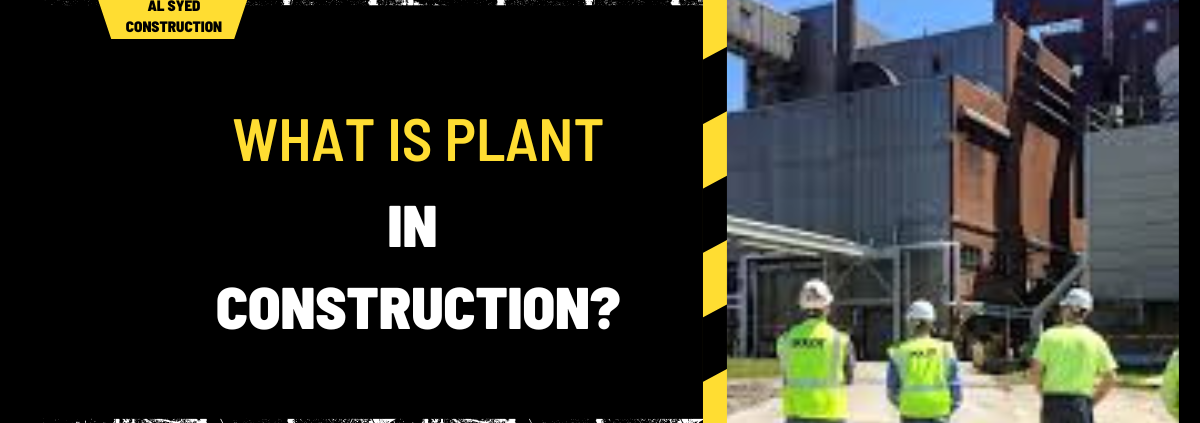What is Plant in Construction?
Table of Contents
Introduction to Plant in Construction
In the construction industry, the term “plant” refers to the machinery, equipment, and vehicles used to carry out various construction tasks. This encompasses a wide range of tools and machinery essential for the efficient and effective completion of construction projects. The use of construction plant can significantly enhance productivity, improve safety, and ensure the quality of work.
Types of Construction Plant
1. Earthmoving Equipment
Earthmoving equipment is critical for preparing the site, excavating soil, and handling materials. Key types include:
- Excavators: Used for digging trenches, foundations, and handling large objects.
- Bulldozers: Ideal for pushing large quantities of soil or debris, clearing land, and rough grading.
- Loaders: Versatile machines used for moving materials such as soil, gravel, and sand.
2. Lifting Equipment
Lifting equipment is essential for moving heavy materials and components to higher elevations. This category includes:
- Cranes: Tower cranes, mobile cranes, and crawler cranes are used for lifting and placing materials at various heights.
- Hoists: Utilized for lifting and lowering materials vertically, often seen in multi-story construction.
3. Concrete Equipment
Concrete equipment ensures the efficient mixing, transportation, and placement of concrete. Important machines include:
- Concrete Mixers: Used to mix cement, aggregates, and water to form concrete.
- Concrete Pumps: Facilitate the transfer of liquid concrete to the desired location, often over long distances or to high elevations.
- Batching Plants: Large-scale facilities that produce concrete in bulk quantities, ensuring consistency and quality.
4. Road Construction Equipment
Road construction equipment is vital for building and maintaining roadways. Key equipment includes:
- Asphalt Pavers: Lay asphalt on roads, bridges, parking lots, and other surfaces.
- Road Rollers: Compact and level the asphalt to create a smooth, durable surface.
- Graders: Used for grading and leveling soil and gravel to prepare for paving.
5. Material Handling Equipment
Material handling equipment is essential for moving and storing materials on construction sites. This includes:
- Forklifts: Used for lifting and transporting materials over short distances.
- Telehandlers: Versatile machines that can lift materials to greater heights and distances than forklifts.
- Conveyor Belts: Automated systems for moving materials across a site or within a facility.
Importance of Plant in Construction
1. Increased Productivity
The use of construction plant significantly increases productivity by automating and speeding up tasks that would otherwise require extensive manual labor. This leads to faster project completion and reduced labor costs.
2. Enhanced Safety
Construction plant enhances safety on-site by reducing the physical strain on workers and minimizing the risk of accidents. Machines are equipped with safety features and can handle tasks that are too dangerous for manual labor.
3. Improved Quality
Construction plant ensures improved quality of work through precise and consistent operations. For example, concrete pumps deliver a uniform mix of concrete, while excavators dig trenches with accurate dimensions.
4. Cost Efficiency
Despite the initial investment, the use of construction plant leads to cost efficiency in the long run. Reduced labor costs, faster project timelines, and minimized material waste contribute to overall savings.
5. Versatility
Modern construction plant offers versatility in handling various tasks across different types of projects. Whether it’s residential, commercial, or infrastructure development, there is a wide range of equipment to meet specific needs.
Challenges in Using Construction Plant
1. High Initial Investment
Acquiring construction plant requires a high initial investment. This includes the cost of purchasing or leasing equipment, as well as expenses related to transportation, storage, and maintenance.
2. Maintenance and Repairs
Regular maintenance and repairs are essential to keep the equipment in optimal working condition. This can be costly and time-consuming, but it is necessary to prevent breakdowns and ensure safety.
3. Skilled Operators
Effective use of construction plant requires skilled operators who are trained to handle the machinery safely and efficiently. Investing in training and certification is crucial for maximizing the benefits of construction plant.
4. Environmental Impact
The use of construction plant can have a significant environmental impact. This includes emissions from fuel-powered machinery and noise pollution. Implementing eco-friendly practices and using energy-efficient equipment can mitigate these effects.
5. Logistics and Site Management
Managing the logistics of transporting and deploying construction plant on-site can be complex. Proper site management is necessary to ensure that equipment is used efficiently and does not cause delays or disruptions.
Future Trends in Construction Plant
1. Automation and Robotics
The future of construction plant is likely to see increased automation and robotics. Autonomous machinery and robotic systems can perform tasks with greater precision and efficiency, reducing the need for human intervention.
2. Sustainable Practices
Sustainability is becoming a priority in the construction industry. Future trends include the development and use of eco-friendly construction plant that minimizes environmental impact. This includes electric and hybrid machinery, as well as equipment designed to reduce waste and energy consumption.
3. Advanced Technology Integration
The integration of advanced technology such as GPS, IoT, and AI will enhance the capabilities of construction plant. These technologies can improve site management, equipment tracking, and predictive maintenance.
4. Modular Construction
The rise of modular construction methods will influence the use of construction plant. Equipment will be adapted to handle the specific requirements of modular building processes, such as the transportation and assembly of prefabricated components.
Conclusion
In the construction industry, plant refers to the essential machinery, equipment, and vehicles that facilitate various construction tasks. The use of construction plant enhances productivity, safety, quality, and cost efficiency. Despite challenges such as high initial investment and maintenance requirements, the benefits of using construction plant are substantial. As the industry evolves, trends such as automation, sustainability, and advanced technology integration will shape the future of construction plant, further revolutionizing the way we build.




